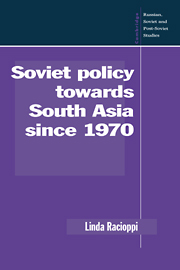Book contents
- Frontmatter
- Contents
- List of tables
- Acknowledgments
- 1 Introduction: South Asia in the USSR's Third World policy
- 2 Soviet perceptions of the Third World and South Asia
- 3 The Soviet Union in South Asia: objectives and instruments
- 4 Stability and change in Soviet–South Asian relations, 1970–1978
- 5 Soviet–South Asian relations in the wake of Afghanistan, 1978–1985
- 6 Soviet Policy towards South Asia in the Gorbachev era
- 7 Conclusion
- Notes
- Index
- Soviet and East European Studies
5 - Soviet–South Asian relations in the wake of Afghanistan, 1978–1985
Published online by Cambridge University Press: 15 December 2009
- Frontmatter
- Contents
- List of tables
- Acknowledgments
- 1 Introduction: South Asia in the USSR's Third World policy
- 2 Soviet perceptions of the Third World and South Asia
- 3 The Soviet Union in South Asia: objectives and instruments
- 4 Stability and change in Soviet–South Asian relations, 1970–1978
- 5 Soviet–South Asian relations in the wake of Afghanistan, 1978–1985
- 6 Soviet Policy towards South Asia in the Gorbachev era
- 7 Conclusion
- Notes
- Index
- Soviet and East European Studies
Summary
Introduction
The early 1970s saw the USSR concentrating its efforts in South Asia on the subcontinent proper: the decade began with the Bangladeshi national liberation movement and another Indo-Pakistani war. International concerns about the region were heightened once again by India's detonation of a nuclear device, which had repercussions not only for the tensions between India and Pakistan but also for China. By the late 1970s, however, the USSR was forced to shift its focus away from concerns about Indo-Pakistan enmity and domestic politics in the southern states of the region to the rising instability in southwest Asia. Despite the fact that there was no fundamental realignment of Indian foreign policy, the USSR's relations with the Desai regime were not as close as they had been with Mrs. Gandhi. Political conditions in Pakistan had deteriorated in 1976 such that by 1977, Bhutto had been ousted in a military coup led by Zia ul-Haq who promised to reinvigorate Islam in Pakistan. The USSR and the rest of the world watched with concern as Bhutto was put on trial, convicted, and sentenced to death, despite heavy international protest. In 1978, the regime of the Shah of Iran also came under heavy pressure from a variety of opposition groups; the 1979 revolution brought to another country in southwest Asia a movement to “re-Islamicize” society.
- Type
- Chapter
- Information
- Soviet Policy towards South Asia since 1970 , pp. 107 - 147Publisher: Cambridge University PressPrint publication year: 1994



